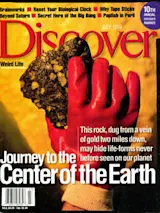The millions of patriotic Americans who willingly put up with traffic jams, mosquitoes, and neck cramps to gaze upward at man-made pyrotechnics each Fourth of July tend to forget that other nights of the month also offer their own wealth of spectacular celestial objects.
A perfect example: Venus, the dazzling evening star, which dramatically pops out of the western sky as twilight fades at around 9 P.M. The planet's sudden appearance will fool many into believing they're seeing an airplane or even a UFO. Our nearest planetary neighbor--shining at a magnitude -5, which is 100 times brighter than any other star in the sky--hasn't been this brilliant in nearly two years.
On July 15, Venus, along with our own crescent moon and the blue star Regulus, will bunch tightly together for a rare conjunction. A close meeting of Venus and the moon, the night's two most brilliant objects, is always ...














